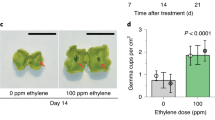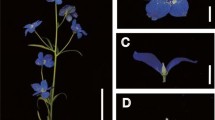Abstract
The plant hormone ethylene triggers and enhanced ethylene synthesis in certain ripening fruits and senescing flowers. Unlike most carnation (Dianthus caryophyllus L.) cultivars exhibiting climacteric rise in ethylene production at the onset of senescence, cv. Sandrosa does not show this phenomenon naturally. In order to understand the mechanism of autocatalytic ethylene production, we exposed carnation flowers cv. Sandrosa to ethylene which resulted in an enhanced capacity for ethylene synthesis in the petals. A short time response of one hour was measured for an increase in ACC oxidase activity, about five hours in advance of an increase in ACC synthase activity and ethylene production. The observed enhancement was dependent on the presence of exogeneous ethylene, and could be partially inhibited by prior treatment of the petals with α-amanitin or cycloheximide. The results of the present study suggest that in response to ethylene, activation of an existing enzyme is taking place first. This is followed by an increase in expression of ACC oxidase and ACC synthase mRNAs.
Similar content being viewed by others
Abbreviations
- ACC:
-
1-aminocyclopropane-1-carboxylic acid
- DTT:
-
dithiothreitol
- PMSF:
-
phenyl-methylsulfonyl fluoride
- SAM:
-
S-adenosyl-L-methionine
References
Abeles FB (1973) Ethylene in Plant Biology. Academic Press, New York
Adams DO and Yang SF (1979) Ethylene biosynthesis: Identification of 1-aminocyclopropane-1-carboxylic acid as an intermediate in the conversion of methionine to ethylene. Proc Natl Acad Sci USA 76: 170–174
Boller T and Kende H (1980) Regulation of wound ethylene synthesis in plants. Nature 286: 259–260
Bufler G (1986) Ethylene promoted conversion of 1-aminocyclopropane-1-carboxylic acid to ethylene in peel of apple at various stages of fruit development. Plant Physiol 80: 539–543
Guy M and Kende H (1984) Conversion of 1-aminocyclopropane-1-carboxylic acid to ethylene by isolated vacuoles of Pisum sativum L. Planta 160: 281–285
Halevy AH and Mayak S (1979). Senescence and post-harvest physiology of cut flowers, Part 1. Hort Rev 1: 204–236
Halevy AH and Mayak S (1981) Senescence and post-harvest physiology of cut flowers, Part 2. Hort Rev 3: 59–143
Imaseki H (1991) The biochemistry of ethylene biosynthesis. In: Mattoo AK and Suttle JC (eds) The Plant Hormone Ethylen, pp 1–20. CRC Press, Boca Raton
Lieberman MA (1979) Biosynthesis and action of ethylene. Annu Rev Plant Physiol 30: 533–591
LiuY, Hoffman NE and Yang SF (1985) Promotion by ethylene of the capability to convert 1-aminocyclo propane-1-carboxylic acid to ethylene in preclimacteric tomato and cantaloupe fruits. Plant Physiol 77: 407–411
Lizada MCC and Yang SF (1979) A simple and sensitive assay for 1-aminocyclopropane-1-carboxylic acid. Anal Biochem 100: 140–150
Mayak S and Tirosh T (1993) Unusual ethylene-related behavior in senescing flowers of the carnation Sandrosa. Physiol Plant 88: 420–426
Tirosh T and Mayak S (1988) Changes in starch content during the development of carnation petals. J Plant Physiol 133: 351–363
Whitehead CS, Halevy AH and Reid MS (1984) Control of ethylene synthesis during development and senescence of carnation petals. J Am Soc Hort Sci 109: 473–475
Wang H and Woodson WR (1989) Reversible inhibition of ethylene action and interruption of petal senescence in carnation flowers by norbornadiene. Plant Physiol 89: 434–438
Woltering EJ (1990) Interrelationship between the different flower parts during emasculation-induced senescence in Cymbidium flowers. J Exp Bot 41: 1021–1029
Woodson WR, Park KY, Drory A, Larsen PB and Wang H (1992) Expression of ethylene biosynthetic pathway transcripts in senescing carnation flowers. Plant Physiol 99: 526–532
Yang SF (1987) The role of ethylene and ethylene synthesis in fruit ripening. In: Thomson WW, Nothagel EA and Huffaker RC (eds) Plant Senescence: Its Biochemistry and Physiology, pp 156–166, American Society of Plant Physiologists, Rockville, MD
Yang SF and Hoffman NE (1984) Ethylene biosynthesis and its regulation in higher plants. Annu Rev Plant Physiol 35: 155–189
Author information
Authors and Affiliations
Rights and permissions
About this article
Cite this article
Jiang, W.B., Mayak, S. & Halevy, A.H. The mechanism involved in ethylene-enhanced ethylene synthesis in carnations. Plant Growth Regul 14, 133–138 (1994). https://doi.org/10.1007/BF00025214
Received:
Accepted:
Issue Date:
DOI: https://doi.org/10.1007/BF00025214




